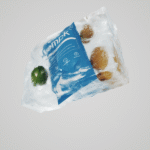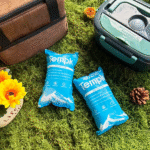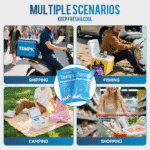Desconto pacote de gelo seco: How to Buy Smart and Ship Colder
If you’re hunting for a discount dry ice pack that still hits -78.5°C performance, you want savings without spoilage. This guide shows how to pick the right pack size, calculate sublimation, and comply with IATA PI 954 in plain English—so you can lock in colder lanes and lower unit cost at the same time.

-
How to choose sizes and formats for long-haul lanes (VIP, EPS, PPE)
-
How many pounds of dry ice you actually need per day (with buffer)
-
What regulations and labels you must apply for UN1845 shipments
-
Where “discount” really lives: Quantidade mínima, freight class, e design de embalagem
-
2025 tendências: sistemas reutilizáveis, Forros VIP, and smarter forecasting
How do you choose the right discount dry ice pack for your lane?
Resposta curta: Match refrigerant pounds to real-world sublimation and pair it with the smallest box that meets your hold-time target. Start from lane time-in-transit, Adicione um buffer de atraso, then select a pack that fits the box with airflow for venting.
Por que funciona
Think in days, not miles. If your lane is 48 hours door-to-door, planejar para 2 days of sublimation plus 20–30% buffer for heat and delays. Many shippers use 5–10 lb por 24 h as the planning range and then tune after pilots. This keeps the bill of materials lean while protecting product quality on hotter routes.
What pack format is best for “discount” buyers?
Blocks vs.. Pellets vs.. folhas
Blocks last longer per pound; pellets fill dead space better. Sheets/pouches are tidy for kitted “pack-outs” with less pick time. Use blocks for long routes where minimal surface area reduces sublimation; switch to pellets when you must nest refrigerant around oddly-shaped goods.
| Formatar | Melhor para | Cuidados | O que isso significa para você |
|---|---|---|---|
| Bloquear | Pistas longas, big boxes | Slower pull-down, less contact area | Menos peças, longer life, simpler SOP |
| Pellets | Espaços apertados, pull-down rápido | Faster sublimation if loosely packed | Great for mixed-SKU e‑comm kits |
| Sheets/Pouches | Clean kitting, standardized SKUs | May cost more per lb | Faster packing, less training time |
Practical tips for unit-cost savings
-
Engineer the box first. Optimize internal dims, then buy the cheapest refrigerant that hits your spec.
-
Push consolidation. Larger outer cartons reduce per-pound freight and refrigerant handling.
-
SKU discipline. Standardize 2–3 pack-outs that cover 80% of orders; buy those packs in bulk for price breaks.
-
Thermal pre-conditioning. Pre-chill goods and inner packs; starting colder can reduce refrigerant pounds noticeably.
Real-world mini-case: A West Coast meal-kit brand moved from ad‑hoc pellet scoops to a two-block standard in a 1.5” urethane shipper with a 25% buffer de atraso. Spoilage dropped below 0.5%, and per‑order cost fell by 9% due to faster pack time and lower overfill.
What regulations apply when you ship a discount dry ice pack by air?
Resposta curta: Use the proper shipping name “Carbon dioxide, sólido,” mark UN1845, Aplique a classe 9 rótulo, list the net weight of dry ice, and ensure the packaging vents CO₂ gas. Passenger and cargo aircraft have quantity limits and operator variations. Always check the latest PI 954 before tender.
-
Marcações: shipper/consignee address, proper shipping name and UN number, peso líquido de gelo seco.
-
Embalagem: must permit venting to prevent pressure build‑up; never seal CO₂ in a tight container.
-
Quantidade: typical limits allow up to ~200 kg per package depending on aircraft type and carrier variation.
-
Documentação: align your Air Waybill and internal SOP with PI 954 language.
How many pounds of dry ice per day should you plan?
Regra geral: 5–10 lb por 24 h in a well‑insulated shipper—then add a 20–30% buffer for heat, atrasos, and weekend handoffs. For a two‑day lane carrying ≤12.5 lb of product, budget around 20 Libra de gelo seco, then refine after pilots. If you’re using a thin EPS shipper, bias toward the high end; com VIP, you can often cut pounds while holding time.
Why does sublimation vary so much?
Surface area, insulation value (VIP vs EPS), hora ambiente, and how you place the packs all matter. In FAA testing of small parcels, average sublimation around ~2%/hora was observed under certain conditions; real‑world results differ by box design, pack-out, e clima. That’s why post‑pilot telemetry and spot checks are part of a good QA loop.
| Motorista | Low-cost move | Effect on pounds | O que isso significa para você |
|---|---|---|---|
| Isolamento | Upgrade to 1.5–2.0” urethane or VIP liner | ↓ 10–40% | Menos refrigerante, caixa menor |
| Colocação do pacote | Keep refrigerant above product with airflow | ↓ 5–15% | Better cold sink, safer venting |
| Start temperature | Pre-chill payload & esteiras | ↓ 5–10% | Pull-down mais rápido, menos desperdício |
| Tamanho da caixa | Reduza o espaço livre | ↓ 5–20% | Cheaper freight, fewer packs |
Calculadora rápida (use in pilots)
-
Duração da pista (horas) ÷ 24 = base days
-
Multiplicar por 7.5 lb/dia (ponto médio de 5-10)
-
Adicionar 25% buffer
-
Round up to nearest 5 Libra block size
How do VIP shippers change the math for discount buyers?
Resposta curta: VIP (vacuum insulated panel) liners extend hold time 2–3× vs. conventional foam, so you can cut refrigerant pounds and freight. For lanes over 72 h, VIP solutions often win total landed cost despite higher unit price. Many stock VIP kits can maintain 2–8°C or deep‑frozen ranges beyond 120 horas, especially when paired with PCM or staged refrigerant.
Quando você deveria não choose VIP?
If your average lane is <36 h and ambient is mild, you may never earn back the added materials cost. Pilot both options: where spoilage is already near zero, stick with EPS/EPP and focus on pack-out speed.
Where does the word “discount” really come from?
-
MOQ tiers: Ask vendors for price breaks at 500, 1,000, e 5,000 unidades; align with forecast.
-
Freight class: Ship denser blocks on pallets; avoid dimensional surcharges on fluffy dunnage.
-
Kitting labor: A clean SOP often saves more than a tiny price drop on refrigerant.
-
Dimensionamento correto: Eliminate one carton size and consolidate volumes to improve purchasing leverage.
2025 developments shaping discount dry ice pack strategy
Panorama geral: Cold chain demand is rising across food and pharma, while reusable systems and smarter insulation reduce ongoing costs. The packaging segment alone is in multi‑billion growth, and VIP/reusable systems are scaling as brands seek cost and sustainability wins.
Fast takes
-
Reusable kits expand. Reusables lower long‑run unit cost and waste, especially on predictable reverse‑logistics lanes.
-
VIP gets mainstream. 2–3× hold-time gains make the refrigerant plan lighter; fewer pounds = lower freight.
-
Forecasting improves. Better lane analytics reduce overfill and out‑of-stock risk on refrigerant SKUs.
Insight de mercado: Expect steady growth in temperature‑controlled packaging and reusables through 2030+, driven by e‑grocery and biologics. Budget for higher service levels, but plan to offset via smarter insulation and standardized pack-outs.
Perguntas frequentes
Q1: Is a discount dry ice pack the same as gel packs?
Não. Dry ice is solid CO₂ at -78.5°C for deep‑frozen shipping. Gel packs or PCMs hold at higher setpoints (por exemplo, 0°C, 2–8 ° C.). Choose based on your product’s required temperature band.
Q2: Can I ship a discount dry ice pack internationally by air?
Sim, but follow PI 954. Marque “dióxido de carbono, sólido,”adicionar UN1845, Aula 9 rótulo, and list dry ice net weight. Ensure venting and check airline variations.
Q3: Why did my dry ice vanish faster than expected?
Likely high ambient temps, isolamento fino, too much headspace, or loose pellets. Tighten the pack‑out and consider upgrading to urethane or VIP liners.
Q4: How many packs should I keep on hand?
Plan inventory from lane forecasts plus a weekend buffer. Standardize to 2–3 SKUs and buy those in bulk to unlock real discounts.
Q5: Can VIP save money if it costs more upfront?
Muitas vezes, sim. If it cuts 30–40% of refrigerant pounds and shrinks the box, you save on freight and damages over the year—especially on 72–120 h lanes.
Resumo & PRÓXIMOS PASSOS
Pontos -chave: Padronize embalagens, size refrigerant from lane duration, Adicione a 25% buffer, and label PI 954 corretamente. Use VIP where lanes are long or hot, and chase discounts through MOQs, tamanho certo, and labor wins—not just per‑pound price.
Plano de ação: Pilot two pack‑outs (EPS vs VIP) on your longest lane, registro de tempo, then lock in bulk buys at the tier where you hit a clear price break. Need help with sizing or SOPs? Talk to us—Tempk can model your lane and hand back a validated pack-out in days.
Sobre Tempk
We build practical cold chain solutions for food and life sciences. Our pack‑out kits, Forros VIP, and lane analytics help you ship colder with fewer pounds of refrigerant. Customers choose us for fast pilots and measurable savings. Let’s tailor a discount dry ice pack program to your lanes.
CTA: Email us at sales@tempk.com or book a lane assessment on our site.























